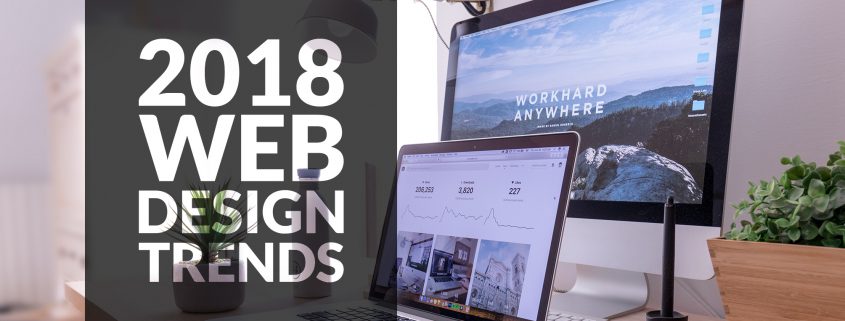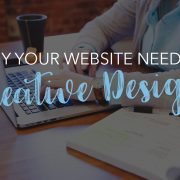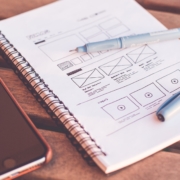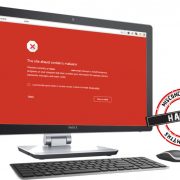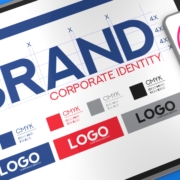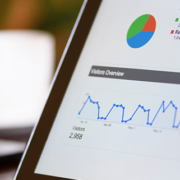Your Guide to the Best 2018 Web Design Trends
Did you know 57.7% of small to medium business owners intend to invest in a new or redesigned website?
There’s a high chance that you’re one of them. So how can you make sure you make an investment that will last?
Have an impact?
Create the ultimate online user experience?
We’ve got you covered. Here are the top 2018 web design trends to create a killer design sure to be ahead of the curve.
The Top 2018 Web Design Trends to Implement Now
1. Mobile First Design
This is website redesign 101 in 2018. You can’t afford to NOT build a mobile-first site in today’s ever-on-the-move culture.
Your website’s design should be based on functioning well and looking good on a mobile device before being translated to a desktop version.
Traditionally, websites were built with a desktop screen in mind. Then they were translated into a mobile version.
Or worse, weren’t optimized for mobile at all.
Today designers have flipped that on its head… at least the good ones. When looking for the perfect website designer, be sure to ask how they structure their design.
The answer should be mobile first. You’ll set yourself up to have a website that will be quickly outdated if you don’t focus on appealing to the smartphone masses.
A mobile first design will likely include less large photos and things like icons to add minimized aesthetic.
Your menu should keep mobile in mind too. And depending on the length of your pages, you’ll want to consider thumb cramping scroll times.
2. Animation or Particle Backgrounds
Having a video as your website header can look cool. But the fact is, 39% of visitors will leave a website if your images don’t load or take too long to load.
That first impression is priceless… and could make or break your business.
Designers have solved this problem in creative ways with 2018 web design trends.
Particle backgrounds are one of those solutions. They overcome the performance issues associated with video while still providing eye-catching movement.
These animations are javascript that is easy to load in a hot second. They create natural movement in the background without the slow grind of a video.
3. Big and Bold Typography
Typography has always been used in web design to evoke emotion and set the tone of a website in addition to conveying important information.
But when it comes to 2018 web design trends, typography is taking on a whole new bold statement.
Custom fonts are more popular than ever before. With the exception of Internet Explorer, most browsers are capable of supporting custom CSS fonts that stand out.
Large letters, contrasting fonts, and bold statements are being used to keep readers on the page and browsing content.
4. Asymmetrical Grid Layouts
‘Broken’ web designs took over in 2017 and this trend is going nowhere fast.
Blocky, asymmetrical layouts are being used to create a completely unique experience for the web browser.
The best part about this trend?
Many big brands with a lot of content are still using traditional grid layouts. So if you jump on board, you’re sure to stand out from the crowd.
Before long we’ll see bigger brands that can afford to boldly break up their design experimenting in this department.
5. Layered Designs with Shadow
Gone are the days of 2D. Enter the multi-layered designs of 2018 with depth and shadow.
But shadows have been around a while… so why is it making the list for our top 2018 web design trends?
Because with more progression of web browsers, we’re seeing exciting variations in the design world.
Parallax and grid designs are more popular than ever. Designers are using them to play with depth and shadow more than ever before.
In 2018, we’re seeing the illusion of a world beyond the screen played out in modern web design.
6. Responsive Logos
Your logo has more function on your site than to show that the website is yours.
In fact, in a study a few years ago, researchers found 36% of visitors will click on the logo of a website to return home.
The point is, your users rely on your logo for both brand awareness and function.
And when it comes to 2018 web design trends, many big brands are hopping on board with the trend of responsive logos to create an awesome user experience for both.
A responsive logo is a logo that varies in shape, size, and design depending on the device it’s being viewed on.
For example, it could be a wide logo with the company name for a desktop and a small square design with the companies initials for mobile. This small touch can have a big impact on the overall effect of the logo design.
The letters will never be too small to read. The design will always be aesthetic. And the logo itself will always feel accessible to the user.
7. Geometric Elements
You know your website needs a creative design that will stand out from your competition’s online…but that’s easier said than done.
Enter 90’s style geometric design. Bold shapes, bright colors, and the simplicity of old design updated to be modernly aesthetic.
This update on old design is pleasing to the user experience, too. You know that nostalgic feeling you get when you hear an old song remixed on the radio?
The same feeling can be achieved with these comforting geometric elements.
There is a familiarity and cohesiveness that can be created to achieve harmony among the entire site. This can create a heightened awareness around a call to actions and information for the user.
8. Open White, Intentional Blank Space
Blank white space has become a statement on its own in web design. It gives the user a peaceful, non-rushed feeling that’s missing in a lot of marketing.
Designers are going ‘back-to-basics’ style with a minimalist design. Sharp angles, grid-like structures, and thoughtful elements with their own space are some of the major 2018 web design trends.
Does your website feel cluttered?
You aren’t alone. Over the last decade, design has included themes with very in-your-face elements.
But the way of the future is to bring it back to basics. How can you create clarity and freshness in your design?
Ask your designer to give each element its own space and give your users space to breath while browsing your site.
9. Vibrant and Highly Saturated Color Palettes
Color schemes used to be a safe-play only zone for web design. Many brands were worried about sending users away by using bright and bold color.
But today, things have changed.
Web-safe colors are no more as big companies pave the way with bold, courageous schemes.
Tech advances are working in designer’s favor as monitors allow for saturated, deep colors to steal the show.
This is a great area for new or developing brands to play if they want to stand out as non-traditional and as non-conformists.
10. Story Telling Through Design
The world of 2018 web design trends is taking a unique approach to what a website’s purpose is.
Now, more than ever, designers are using websites as a platform to tell a story. And not just with words…with animation and design.
Aesthetics are no longer only for brand awareness and to accentuate the beauty of a website. It’s now being used to express a story around a brand.
Animated logos, interactive design, and other amazing elements are being brought to life in web design to create a unique user experience.
11. Artificial Intelligence Implementation
Web design is using conversational interfaces as a new way to engage visitors while they’re actively scrolling a site.
As this trend develops, unique and experimental ways to incorporate AI into designs are beginning to appear.
Sometimes this means having AI at the forefront of a design and very obvious. Other times this means AI is an almost invisible and natural element to a website design.
The reality is, as users become more and more accustomed to AI like chatbots, their popularity will increase.
Artificial Narrow Intelligence (ANI) is already powering the likes of Amazon, Spotify, and Netflix. This advanced technology uses voice assistance to make recommendations in alignment with a visitor’s desires.
This is a great way for companies to engage their user in a unique and personal way. Ultimately, what this technology strives to do is give users more of what they want and eliminate the rest. This can help visitors to more quickly find what they’re looking for and make a purchasing decision.
The other key advantage to a conversational interface is addressing concerns or questions. Rather than a user falling off your website because they couldn’t find the information they were looking for, chatbots allow them to ask for whatever it is they need.
And they can do it all without ever picking up a phone or sending an email.
Next Steps for More Creative Ideas
It’s easy to lose touch with what’s happening in the fast-paced business world. Are you looking to stay up-to-date on the latest 2018 web design trends and more?
Stay connected here to follow regular tech updates and other pro-business tips.

